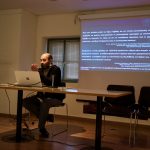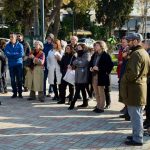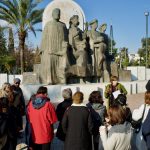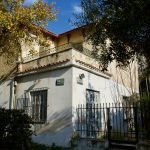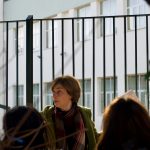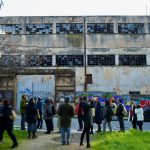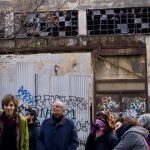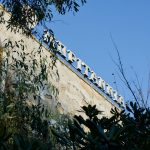Συνοπτική Περιγραφή της Έρευνας
Το προτεινόμενο έργο θα εξετάσει τις δραστηριότητες των Ελλήνων αρχαιολόγων στη Μικρά Ασία το διάστημα 1919-1922 και τον ρόλο τους στη σύνθεση των εθνικών ταυτοτήτων στη Νοτιοανατολική Ευρώπη και την Τουρκία, μετά τον Α’ Παγκόσμιο Πόλεμο. Η έρευνα θα βασιστεί σε βιβλιογραφική και αρχειακή έρευνα, συνθέτοντας ένα σύνολο πληροφορίας για κάποιες αρχαιολογικές θέσεις στη Μικρά Ασία – θέατρα μιας ιδιότυπης ‘συγκρουσιακής’ αρχαιολογίας και διαχείρισης μνημείων στις αρχές του 20ου αιώνα.
Το έργο αποτελεί μια συστηματική έρευνα και σύνθεση δεδομένων σχετικά με τις δραστηριότητες της Αρχαιολογικής Αποστολής Μικράς Ασίας (1919-1922), τις εξέχουσες προσωπικότητες που τη στελέχωσαν και τον ρόλο τους στο πολιτικό περικείμενο κατά τη διάρκεια της αποσύνθεσης της Οθωμανικής Αυτοκρατορίας και του αυξανόμενου οικονομικού ανταγωνισμού των Ευρωπαϊκών δυνάμεων στην περιοχή.
Τα κύρια ερευνητικά ερωτήματα που θα μελετηθούν περιλαμβάνουν:
- Την εξέταση της επιλογής των συγκεκριμένων θέσεων για αρχαιολογική διερεύνηση, τον τρόπο διερεύνησής τους και κάποια από τα ευρήματα.
- Τη μελέτη των δραστηριοτήτων της Αρχαιολογικής Αποστολής Μικράς Ασίας και των σχέσεών τους με τα σύγχρονα πολιτιστικά έργα στην Ελλάδα και την Τουρκία, εξετάζοντας παράλληλα το πώς ο ‘κλασικισμός’ και η ‘βυζαντινή ταυτότητα’ συνέβαλαν στη σύνθεση των εθνικών κρατών στις αρχές του 20ου αιώνα.
- Την ανάλυση της σχέσης μεταξύ των δραστηριοτήτων της Αρχαιολογικής Αποστολής και της ανασκαφής/μετακίνησης των αρχαιοτήτων στη Μικρά Ασία μετά τον Α’ Παγκόσμιο Πόλεμο από άλλα ξένα αρχαιολογικά ιδρύματα.
- Την εξέταση του τρόπου με τον οποίο οι ανακαλυπτόμενες αρχαιότητες οργανώθηκαν σε διαφορετικά εθνικά αφηγήματα και τη δυνατότητα που μας δίνει αυτός ως σημείο αναφοράς για να προσεγγίσουμε χρήσεις και καταχρήσεις της πολιτιστικής κληρονομιάς στη δημιουργία ‘εθνικής συνείδησης’ για τις ‘φαντασιακές κοινότητες’ της Νοτιοανατολικής Ευρώπης στις αρχές του 20ου αιώνα.
- Την προοπτική θεώρηση αυτής της μελέτης περίπτωσης -για τη χρήση της πολιτιστικής κληρονομιάς σε μια ταραχώδη περίοδο- ως βάση για μελλοντικά προγράμματα, με σκοπό την προώθηση της αλληλοκατανόησης και της συνεργασίας μεταξύ Ελλάδας και Τουρκίας.
- Την εξέταση της αξίας της αρχαιολογικής γνώσης που δημιουργήθηκε στις αρχές του 20ου αιώνα, ως βάση για συνεργατικά σχέδια διαχείρισης αρχαιολογικών θέσεων με αντικρουόμενες ιστορίες/ερμηνείες, όπως και των υπό συζήτηση.
Το προτεινόμενο έργο είναι η τελευταία φάση ενός ευρύτερου προγράμματος που εκκίνησε το 2007 και ολοκληρώνεται με τη σύνθεση ενός μικρού βιβλίου, το 2019, εκατό χρόνια μετά την απόβαση των ελληνικών δυνάμεων στη Μικρά Ασία.
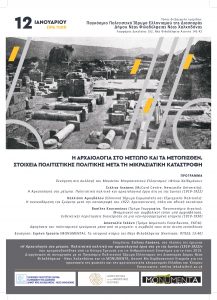 Ημερίδα
Ημερίδα
«Η αρχαιολογία στο μέτωπο και τα μετόπισθεν. Στοιχεία πολιτιστικής πολιτικής μετά τη Μικρασιατική Καταστροφή»
Παγκόσμιο Πολιτιστικό Ίδρυμα Ελληνισμού Διασποράς
Λεωφόρος Δεκελείας 127, Νέα Φιλαδέλφεια Αττικής 143 42
Κυριακή 12 Ιανουαρίου 2020, 11:00 π.μ.
Η ημερίδα πραγματοποιείται στο πλαίσιο της έρευνας με τίτλο «Η Αρχαιολογία στο μέτωπο. Πολιτιστική πολιτική και αρχαιολογικά έργα στη γη της Ιωνίας (1919-1922)» που χρηματοδοτήθηκε από το Κέντρο Έρευνας για τις Ανθρωπιστικές Επιστήμες για το έτος 2019. Σε συνεργασία με το Παγκόσμιο Πολιτιστικό Ίδρυμα Ελληνισμού της Διασποράς Δήμου Νέας Φιλαδέλφειας – Νέας Χαλκηδόνας και τη MONUMENTA, Αστική Μη Κερδοσκοπική Εταιρεία για την προστασία της φυσικής και της αρχιτεκτονικής κληρονομιάς Ελλάδας και Κύπρου.
Πρόγραμμα
Ξενάγηση στη συλλογή του Μουσείο Μικρασιατικού Ελληνισμού «Φιλιώ Χαϊδεμένου»
Στέλιος Λεκάκης (McCord Centre, Newcastle University):
Η Αρχαιολογία στο μέτωπο. Πολιτιστική πολιτική και αρχαιολογικά έργα στη γη της Ιωνίας (1919-1922)
Καλλιόπη Αμυγδάλου (Ελληνικό Ίδρυμα Ευρωπαϊκής και Εξωτερικής Πολιτικής):
Η ανοικοδόμηση της Σμύρνης μετά την καταστροφή του 1922: Αρχιτεκτονική, πόλη και εθνική ταυτότητα
Βασίλης Κουτσούκος (Τμήμα Γεωγραφίας, Πανεπιστήμιο Αιγαίου):
Μνημειακοί και συμβολικοί τόποι υπό αμφισβήτηση. Ενδεικτικές περιπτώσεις διαχείρισης σε μια νέο-προσαρτημένη επαρχία (1919-1930)
Αποστολία Γαλάνη (Τμήμα Δημοτικής Εκπαίδευσης, ΕΚΠΑ):
Αφηγήσεις του πολιτισμικού τραύματος μέσα από τα μνημεία: η συμβολή τους στην άτυπη εκπαίδευση
Ξενάγηση: Ειρήνη Γρατσία (MONUMENTA): Τα ιστορικά κτήρια της Νέας Φιλαδέλφειας
Αφίσα – Πρόγραμμα Ημερίδας (PDF, JPG)
Δελτίο τύπου Ημερίδας (PDF)
Research: “Archaeology on the front line; Cultural politics and archaeological projects in the land of Ionia (1919-1922)”
Researcher: Dr. Stelios Lekakis
The research project “Archaeology on the front line; Cultural politics and archaeological projects in the land of Ionia (1919-1922)” was funded by the Research Centre for the Humanities (RCH) for the year 2019.
- Introduction
The project “Archaeology on the front line; Cultural politics and archaeological projects in the land of Ionia (1919-1922)” examines the archaeological activities conducted by Greek archaeologists in Asia Minor between 1919-1922 and their role in the wider national identity building in south-east Europe and Turkey after World War I, through bibliographical & archival research and brief ethnographic work in specific sites and regions in Turkey – theatres of this particular ‘conflict’ archaeology and heritage management in the early 20th c. The project is amongst the first systematic attempts to research the activities of the Greek Archaeological Service in Asia Minor (1919-1922) and its role in the political context of the area, in the midst of the disintegration of the Ottoman Empire and the growing economic interests of several European countries.
This academic report briefly discusses narratives developed during the project, funded by RCH for the year 2019. This was the last leg of a wider research to be published in 2020-1, one hundred years after the landing of the Greek forces in Asia Minor. The narratives presented here come from processed information retrieved from the archives, the relevant bibliography and focused ethnographic research (see final report), furthering ideas and concepts developed in earlier stages of the project.
1.1 The historic background
On the 27th of June 1917, Greece enters the World War I and, in the Autumn of 1918, after the defeat of the Ottoman forces, finds herself among the victorious Entente powers (Britain, France and Russia). At the Paris Peace Conference (1919), Eleftherios Venizelos, the Greek Prime Minister, lobbied hard for the vision of an expanded Hellas. This ‘Megali Idea’, an irredentist notion deeply rooted in the political and religious consciousness of the Greeks, was expressed in the goal of uniting the lands on either side of the Aegean, incorporating Greek-speaking populations into an expanded Greek nation-state. This otherwise old-school imperial concept is transcribed in a romantic nationalistic ideology nurtured within the boundaries of a small nation-state nearing its centenary and striving to fulfil it through the contradictory promises about post-war territorial gains made by the Allies. Such lands included the coastal area of Asia Minor, considered one of the cradles of ancient Greek civilisation: ‘the holy land of Ionia’.
This notion fitted well in the process of dismembering the ‘Great Patient’, the Ottoman Empire. Lloyd George, the prime minister of Great Britain, considered the Greek interests opposite to the Italian and the French, two countries that were already reacting to the potential of Greece as a British leverage in the Near East and Eastern Mediterranean. Even though the military upgrade of Greece in the area was also questioned by the US, the landing of the Italian forces at SW Turkey in March 1919 expedited the decisions and Venizelos acquired the permit to dispatch Greek forces and occupy the Smyrna zone in May 1919 (Llewellyn Smith 1998).
The Sévres Treaty (10.08.1920) that formalised the Greek occupation, found the Greek army marching East towards Ankara, stumbling upon guerrilla warfare and increasing resistance by the Kemalist forces. In Greece, even though King Constantines’ party (Inomeni Antipolitefsi) disapproved the military expedition to Asia Minor as ‘colonial’, after their colossal win against Fileleftheroi (Venizelos’ party) in the 1920s elections, went on to expand the military front and proceed to and over Sakarya river, fulfilling ‘the dream of the folk’. The end was nearing: the width of the military front, the dwindling moral of the army that has been fighting since the Balkan Wars and the patriotic fervour of the Turkish nationalists brought an end to the military expedition that came to resonate in history as the Asia Minor Catastrophe, denoting the casualties, the ‘lost homelands’ and the more than one million refugees fleeing the land of Ionia towards a safe heaven.
1.2 Greek politics and cultural policy
As mentioned, ‘Megali idea’ was a romantic colonial aspiration utilised by Greece, amidst a changing world (the Interwar period, the Russian Revolution, nationalism in the Balkans, emerging decolonial politics); Its implementation required a ‘Mission civilisatrice’, bringing in the occupied land frames and processes of enculturation for the local population, in order to solidify the argument of the ‘primordial land’ and the ‘rightful belonging’ to a ‘cultured metropolis’ ‘of the two continents and the five seas’ and communicate the results to the rest of the world. Culture and cultural attributes (art, statehood, ethos, dress, heritage) was a potent tool to construct and curate the ownership of the land: The proof of the culture brought to the land of Anatolia by Greeks long before the arrival of the Greek army (Mac Sweeny 2012: 67-8; Stamatopoulos 2011: 63).
Thus, the Greek Government strategically invested in education and high culture in order to ‘enculture’ the local population but most importantly connect back to the ways of mainland Greece. Among the first activities was the establishment of the University of Smyrna; Venizelos himself asked the world-famous mathematician Constantin Carathéodory to organise its structure and courses (Salta 2011: 38). In parallel a number of secondary schools were established in Smyrna (Armosteiako Gymnasion next to the Evaggeliki scholi, Tritaxio Gymnasio Arrenon 1919, Klasiko Gymnasio Thileon 1920, Didaskaleio Nipiagogon). Venizelos also signed a contract (1919) with Fred Boissonnas for a photography series depicting the recently annexed lands (see Smyrne, editions d’art Boissonnas) or the ones of national pursuit. Part of the contract involved a second trip to the Asia Minor military front for Henri Boissonnas (1921) for the collection of material to be published in two albums: La campagne d’ Anatolie and L’ Hellénisme d’ Asie Mineure; a project that could be considered part of the “Greek propaganda”, as Henri confesses to his future fiancée in one of his letters (Boudouri 2012: 17).
Even though not discussed in the classic handbook of the Asia Minor expedition (Llewellyn Smith 1998), archaeology played an important role in this process. As we will observe in the next sections, Greece used archaeology and heritage in an urgent and agonising way, reminding us the case of the ‘Nees Chores’ in Northern Greece a few years earlier, in order to broaden the national identity, to draw links with historical figures, to inspire the administrative and military personnel and to solidify her image abroad as the rightful owner of the past and the present of the annexed new lands (Fig. 1).
- Digging the holy land of Ionia: Greek archaeological activities in Asia Minor 1919-1922
2.1 The Greek Archaeological Service of Asia Minor (GASAM)[1]
Goals and objectives
Almost two months after the landing of the Greek army in Izmir, an Archaeological Service was established as a department of the High Commission of Asia Minor. GASAM’s expressed purpose was to protect ancient monuments, “to salvage and collect movable antiquities everywhere in the Asia Minor hinterland, to conduct excavations for the study of ancient Greek cities of Asia” (Kourouniotes 1924b: 1) but also to manage the remains excavated and the collections organised by foreign archaeological institutes; These were “abandoned and left unguarded by the Ottoman government after the end of World War I, with considerable losses”, as the Greek sources of the time report (Kourouniotes 1924a: 73–87).
GASAM operated for three years following the model of mainland Greece, manned by an Ephor and an Assistant/Curator[2] that were dispatched from Athens to organise the Service and commence the activities.
2.2 Personnel
First director of GASAM ‘by the High Commissioner’ was Georgios Oikonomos (1883-1951) that remained in office until November 1920. Oikonomos was previously Ephor in Argolid & Corinth and director of the Ephoreia of Antiquities “by the General Administration of Macedonia”[3] (1917). After the Catastrophe, he became the 8th Secretery of the Archaeological Society at Athens (ASA, 1924-1951), Director of the Archaeological Service (1933-8) and Archaeology professor at the University of Athens (1928-1951) (Akrivopoulou 2012: 57). A staunch supporter of the Greek monarchy, he believed that “Greek archaeology is not a profession but a mission” (Petrakos 1989: 168)[4]. Second director of GASAM was Konstantinos Kourouniotes (1872-1945) that remained in office until the end of the military expedition and the occupation of Smyrna by the Kemalist forces (01.1921-09.1922). Kourouniotes was an experienced archaeologist (Ephor of Olympia and later Attica) and parallel to/after Asia Minor he became Ephor and director of the National Archaeological Museum (NAM, 1922-1925), Member of the Academy of Athens (elected in 1929), Director of the Archaeological Service (1914-20; 1925-33), Director of the Epigraphic Museum (1933-7), Secretary at ASA and director of the Elefsina excavation (1917-1945) (Salta 2011: 9-12).
Finally, Νikolaos Laskaris was a junior archaeologist, employed in GASAM as Assistant and worked at NAM as curator (Kourouniotis 1924b: 1).
Along with the permanent personel a number of people collaborated or were hired to support the activities of GASAM.
Archaeologists
Georgios Sotiriou (1881-1965) is considered the founder of Byzantine archaeology in Greece. He was dispatched by ASA after Kourouniotes proposal and directed the excavation at Ephesus. In 1923 (June), he became the first director of the Byzantine Museum in Athens, opening a new exhibition with byzantine antiquities, at the time of the First International Byzantinological Conference (1924) (Gratziou 2012: 88-9). Stratis Paraskevaidis was an archaeologist. Serving as a private during the Asia Minor campaign (3/40 Evzones Regiment[5]), he was dispatched and worked with Kourouniotes and Laskaris.
Other Professionals
Anastasios Stephanou (forester, serving at 3rd Army Corps, Bursa-Eşki Sehir) was assigned by Kourouniotes to collect, document, dispatch antiquities in the regions covered by his Army Corps (Eşki Sehir (Δορύλαιο), Kütahya, Bursa, Seyitgazi, Sivrihisar et al.)[6].
Mithridatis Karakotsis (Armenian) worked at Ephesos, dispatched from the Public Works Department of the Greek Governance of Smyrna (Kourouniotes 1924a: 229).
- Petritsis (photographer) documented the Mastavra survey, led by Kourouniotes.
- Chalkiopoulos (photographer) signs some of the photographs surviving (e.g. from Kourouniotes’ travel, Kourouniotes 1925). However, it is possible that he only developed the films.
Guards / Curators / Foremen
Athanasios Apergis, an experienced foreman (working in German excavations), was hired for the Nysa project (Salta 2011: 30).
Aggelos Alivizatos, a teacher at Ephesus was hired for the Ephesus project as a curator.
Laloudis, an experienced marble worker, was hired for the Ephesus project as guard/steward[7], living on site. He was also working for the Austrian Archaeological Institute (Salta 2011: 29)
Artem. Kiosklis, an antiquarian from Pergamon, was hired as guard/curator at Pergamon along with two unnamed guards. Guards were also hired to overlook Sardeis and Priene (Kourouniotes 1924b: 2)
Apart from GASAM, the Archaeological Society at Athens played a significant part in the Asia Minor enculturing mission. ASA, one of the most significant archaeological organisations in Greece, dates back to 1837. In 1917, ASA changed its statute, aiming also to research and protect “byzantine, Christian and other monuments dating up to the Greek Independence”, including antiquities existing in the ‘Nees Chores’, i.e. areas yet to be annexed to Greece (Petrakos 1989: 162-3). ASA stood by the side of “our fighting country, going forward amidst all sorts of heritage remains, by the ancient route of our Macedonian stratelates, represented by those continuing the feats of our ancestors, restoring -through their consecutive victories- the Greek civilisation, where it once originated, stumbling upon each step on ancient remnants, and inscriptions and ruins” (Dragatsis 1921: 13). ASA dispatched Oikonomos and Sotiriou and their work was supported by Prince Nikolaos, vice president of ASA.
2.3 Processes and Activities
Archives and bibliography record a number of relevant activities organised by GASAM, as presented in the (tentative) Table 1. In this report we only discuss the most important of them in the relevant categories: Systematic excavations, test pits, surveys, collecting antiquities, on the ground management (cleaning, guarding), restoration, collections/exhibitions, communication, research permits.
2.3.1 Systematic excavations
Ephesus
Hagios Ioannes Theologos (First Season: 26.07 – 18.09 1921; Second Season: 06.06-20.08.1922)[8]
Undoubtedly, the most impressive project of the Asia Minor Archaeological Service was the excavation of the basilica of Hagios Ioannes Theologos in Ephesus. During the summer of 1921, while the Greek invasion of Anatolia reached a climax, the Archaeological Society at Athens, following an invitation from Kourouniotes, took up a rather impressive endeavour: the excavation of the basilica of Hagios Ioannes Theologos, a famous pilgrim site of the Byzantine period. The Basilica on the acropolis of the byzantine Ephesus, was mentioned by the historian Procopius, as built by Justinian in the 6th c., on the model of Hagioi Apostoloi in Constantinople, bigger in dimensions than the Hagia Sophia (Dragatsis 1921: 15; Sotiriou 1924: 173). It was demolished in 1375 to build the mosque of Aydin Isa (Dragatsis 1921: 14).
During the first season, the excavation was funded with 15.000 drachmas by the High Commission that also provided 20 prisoners[9] to work as workmen. Sotiriou rented excavation tools from the Austrian Archaeological Institute via the steward N. Laloudis and trial pits were dug to locate the width, the gates and the apsis of the basilica. After the second week of systematic excavation an attempt was made to excavate the holy sanctuary. Composite capitals were retrieved, contributing to our understanding of the development of the byzantine architectural sculpture. Theologos’ mausoleum was also located (Sotiriou 1921: 55). In the second season, Sotiriou attempted to define the shape of the temple in greater detail and excavate the mausoleum. He also located another mausoleum possibly belonging to a patriarch. Interesting movable finds were retrieved and architectural members were organised in situ next to their bases (Sotiriou 1924: 26). Prince Nikolaos observed the excavations and contributed in the fundraising (an additional 20.000 drachmas from the High Commission). The High Commissioner, Aristeides Stergiades, visited Efesos “showing greatest interest” (Sotiriou 1924a: 25). 60 workmen were also employed (Sotiriou 1924b: 115). The remnants of the 60m-wide basilica were arranged, a guard (N. Laloudis) and a Greek steward (A. Alevizatos) from the local community were employed, while the moveable finds were sheltered in a renovated mosque nearby (Sotiriou 1924: 97, 115) (Fig.2-4).
Ayasolük
In the wider area of the archaeological site, cleaning activities took place so that various monuments could be visited again. Austrian collections in the Agora were damaged and looted, while some architectural members were transferred to Smyrna to build a public building. Sotiriou repaired some ancient rooms in the Agora, housing the Austrian collections. What is more, an archaeological collection “by the school” was created to host collected inscriptions from the roman aqueduct, opposite the railway station in the fields (Kourouniotes 1924b: 1). Finally, a byzantine collection was created in a small seljuk mosque “on the acropolis, by the gate of the persecutions”, donated by the Ephesus city council, repaired and converted into a special museum for the excavation finds (Sotiriou 1921: 60; Sotiriou 1924a: 28; Sotiriou 1924b: 183-4).
Klazomenai (08 – (interruption to excavate St. John’s islet) end of 09.1921)
- Oikonomos worked in Klazomenai, Anaxagoras’ homeland, next to Alexander’s route to the East, in an attempt to “restore the Greek civilisation, created in the old times” (Dragatsis 1921: 14). He dug various points between Skala Vourla (Urla Işkele) and Vourla Chora (Urla). He focused on ‘Monastirakia’ site (20’ SW of Skala Vourlon, eastern side of a small plane) (Oikonomos 1921: 63). He discovered a cemetery (at least 6 phases) and the famous painted clay sarcophagi (2nd half of 6thc. BC) that are known in bibliography as: ‘Klazomenai sarcophagi’ (Oikonomos 1921: 65). During the second season, he expanded the research towards SW, locating more sarcophagi (40) and other types of graves and pottery. The project was funded by the High Commission (Greek Governance Budget), the Greek Army and Prince Nikolaos (Dragatsis 1921: 14). Oikonomos also records the interest of the local communities and the information they offered (Oikonomos 1921: 63).
Nysa on the Maeander[10] (First season: Summer 1921, Second season: 07-08.1922)
The city of Nysa, mentioned by Strabo and Stephanos Vyzantios, was in an advantageous geographical spot in Karia (North part of the Meander plain, south foothill of Mesogida) and developed in an important commercial and educational centre (Kourouniotes 1924a: 1; Papathanasopoulos 1993: 104). Limited excavations and mapping exercises (1909) were conducted on site by the archaeologists W.v.Diest and H.Pringsheim and the German officers Graefinghoff & v. Koller in the 1910s (Kourouniotes 1924a: 43).
Nysa was built on an impressive system of retaining walls. Kourouniotes focused on the eastern side, where the Agora and the Gerontiko (Council house) lay. In the Agora (1stc. BC), the ground plan (105x89m) was recovered whereas in Gerontiko (Hellenistic, later than 161 BC) its large fore-court with colonnade and multicoloured mosaics (27,45×23,5) reminded Kourouniotes of Miletos’ council house (Kourouniotes 1924a: 43; Papathanasopoulos 1993: 107-8; Woodwards 1924: 74).
During the first season, large scale removal of soil and large stones was attempted, however insufficient preparations and the inexperienced personnel resulted in damaging finds and the early halt of the works (Kourouniotes 1924a: 45, 73, 76). The artistic value of some of the finds prompted Kourouniotes to dispatch antiquities to the Smyrna collection (Kourouniotes 1924a: 49, 61). A guard was employed and protection from military and local authorities ensured (Kourouniotes 1924a: 87). In the second season, better preparations (hiring of the experienced A. Apergis as foreman and 30 workers-convicts from the prisons of Smyrna and Magnisia) and the economic and ethical support by the Greek Governance created expectations for the continuation of the research (continuing excavations, repairs and consolidation in Gerontiko)(Kourouniotes 1924a: 87, 227; Salta 2011: 30). However, the work of Kemalist agents and the uneasiness in the local communities due to the unstable military front hindered the works on the ground, as the convicts stopped co-operating. “Excavation continued up until the last day of the general retreat from the Maeander” while some of the findings were abandoned on site or during their transfer to Smyrna at the railway station of Sultanhisar. Kourouniotes wished that the inscriptions retrieved could be published by the Austrians in the near future (Kourouniotes 1924a: 79, 81) (Fig. 5).
2.3.2 Test pits
Apart from the systematic excavations, test pits were conducted to test hypotheses or retrieve finds and their immediate context. A characteristic example was in Evmeneia (Işıklı), where a small test pit was dug by soldiers, a bit further from the lake where two small arches are situated against the mountain. Kourouniotes thought that this would be a small stoa, probably the sanctuary of the river god. However, no findings confirmed his hypothesis (Kourouniotes 1925: 419).
2.3.3 Surveys
Surveying sites and collecting movable antiquities was a central activity of GASAM, mainly organised and conducted by K. Kourouniotes.
Mastavra (autumn & winter 1921)
Mastavra was a small ancient city, next to Nysa, on both sides of Chrysorroa river (North of Nazili, Ancient Lydia) (Kourouniotes 1924c: 247). Kourouniotes’ survey, escorted by military forces, Laskaris and Petritsis during two brief visits, covered limited ground. They identified a gymnasium, a circular unidentified building, an amphitheatre, and a (roman or byzantine) wall (Fig. 6).
St. John Islet (08-09 1921)
After a brief visit at St. John’s Islet probably in 1920, Oikonomos interrupts his excavation at Monastirakia and excavates there three sites for a few days (Oikonomos 1921: 68, 72). Near the harbour he locates a 150m. paved road (‘η οδός των Κλαζομενών’, hellenistic 150m long, 4m. wide), and remnants of houses by the road, similar to the Priene road network (Oikonomos 1921: 70) (Fig. 7). On the eastern side of the islet, a roman building with mosaic floor, on the north east side small buildings and hellenistic buildings on the northern side, possibly including an Athena sanctuary (inscription and female seated figurines) (Oikonomos 1921: 74). A second season was in his plans (Oikonomos 1921: 71).
2.3.4 Collecting antiquities
Collecting movable antiquities took up significant time and resources of GASAM. Kourouniotes responded to calls of the military personnel coming “across ancient reliefs and inscriptions in many villages, as they were going through” (Kourouniotes 1924a: 2) visiting them in situ or examining the dispatched antiquities from his office in Smyrna. In Kourouniotes 1925, he diligently records one of his travels from Uşak (Timenou Thyrai) to Işıklı (Evmeneia) with Laskaris & Paraskevaidis, visiting all the villages and travelling between the lines to survey, collect and decide what to dispatch at Smyrna. Most of the spotted antiquities were funerary reliefs and inscriptions (c. 180, again mostly funerary) and to a lesser extend byzantine marble architectural members with inscriptions and decoration. Antiquities coming from Çivril, Afyon Karahısar, Kütahya were send to Smyrne and stored in a large military depot (close to ‘Punda’), antiquities coming from Eşki Sehir, Seyitgazi, Bursa were stored in a depot by the railway station (Kourouniotes 1924b: 3). Non-important finds were described and left in-situ to be protected by the army (Fig. 8).
Probably in this travel, Kourouniotes meets Anastasios Stefanou (forester, serving at 3rd Army Corps, Bursa -Eşki Sehir), according to the personal diary of the latter, and after a special permit by the Chief 3rd Army Corps, Kourouniotes assigns to him to collect and document antiquities in the regions covered by his Army Corps (Eşki Sehir (Δορύλαιο), Kütahya, Bursa, Seyitgazi, Sivrihisar et al.). Again, according to Stefanou, the antiquities were destined to adorn a ‘Dorylaio Park’ at Palaio Faliro (Mavris 2012: 22). He finally collects c. 120 bulky, marble finds (capitals, inscriptions, funerary steles, columns) that are abandoned in Mudanya quay after the collapse of the military front (Stefanou 1983: 19). Some of the collected antiquities are thesaurised in his autobiography: Stefanou 1983: 57, 87-94.
Apart from some known antiquities that reached Athens (e.g. ‘to prosfygaki’ NAM 3485 Sculpture collection from Gerontiko, Nysa) collected and dispatched antiquities were stored in various collections in Smyrna[11], destined to adorn the Great Museum of Smyrna (see page 08 in this report). After the great fire of Smyrna (13-22.09.1922) the location of the majority of them remains unknown. In the frames of the project a catalogue is being developed, containing information on the antiquities encountered in Asia Minor by Greek archaeologists (abandoned, transferred or remaining in situ). The catalogue (Table 2) is constantly being enriched with new entries and it will soon be published online with a CC-BY licence (www.unthing.gr/), leading to further research and maybe identification of antiquities in situ, in collections in Greece or Turkey or in the bibliography.
A different category of transferred or abandoned objects is the religious objects and furniture from the local churches in Asia Minor. These were among the first concerns of the refugees and oral history records a series of attempts to protect and smuggle them out of Asia Minor (Kentro Mikrasiatikon Spoudon 2008). Religious objects were considered as vital part of the community memory, a heirloom (κειμήλιο). These objects now rest in Asia Minor museums around Greece, along with household items, costumes and personal objects[12]. However, in most cases refugees were only allowed to take with them whatever they could hold on their hands. Thus, religious objects were discovered and confiscated or abandoned in quays before their embarkation on the boats to Greece (Fig. 9).
2.3.5 On the ground management (cleaning, guarding)
The ancient city of Pergamon was being excavated by the Germans since the middle 19th c. As it was one of the first cities the army encountered in its eastwards marching, Kourouniotes was swift to spot damage on the architectural remains and organise counter measures: Cleaning fill and vegetation, arranged architectural members from excavations, conservation activities on the Gymnasion wall and the retaining wall of Demeter’s sanctuary. He also repaired the collection building at the lower Agora and arranged the antiquities inside. Finally, he hired two guards under the ‘general stewardship’ of the Pergamite antiquarian Artem. Kioskli (Kourouniotes 1924b: 2).
Kourouniotes also acknowledged damages in the excavated material by the Americans in Sardeis (Pottery and small sculptures missing, one Sidamara sarcophagus shattered) (Kourouniotes 1924b: 2). He decided to transfer lydian inscriptions to Smyrna at the collection of the Turkish School by the Military Headquarters (Διοικητήριο) (Kourouniotes 1924b: 2).
Priene on the other hand was relatively untouched and ‘safe as no Turkish communities lived nearby and there was not lush vegetation’. Kourouniotes did not know the state of the collection kept there by the Germans (inscriptions, sculptures, coins, pottery). A guard was hired to protect the site, the same one sent away by the Turks from the archaeological site of Miletus (Kourouniotes 1924b: 2).
2.3.6 Restoration
As we examined above, focused restoration activities also took place in various sites attempting to consolidate architectural features (Gerontiko, Nysa), repair historic buildings for exhibition purposes (small mosque in Ephesos) or enhancing the readability of the remains (Hagios Ioannis Theologos basilica, Ephesos) (Fig. 8).
2.3.7 Collections / exhibitions
The Evaggeliki Scholi collection in Smyrna originally belonged to a Swiss merchant and bought in an auction from a Greek consortium (banks) for the “support of the nation” (Lithoxoou-Salata 1959: 25). Re-arranged by GASAM, the collection included 35.000 volumes in various languages, 180 manuscripts, 15.000 coins and 3.000 objects (pottery and a few sculptures) (Salta 2011: 23; Solomonidis 1962). Antiquities from the collection (mainly pottery) of the Idadie Turkish School, were also stored there (Kourouniotes 1924b: 3). After the great fire of Smyrna the whereabouts of the collection remain unknown. M. Salta (2011: 28) records the donation of roman female marble head, copy of a Hellenistic original (NAM 3616) to NAM, coming from the collection of the Evaggeliki scholi, by the military attaché of the British Empassy L. Bower. Evaggeliki Scholi collection would have been the core of the Great Museum of Smyrna or Asia Minor Museum[13], containing antiquities of ‘explicit beauty and importance’, which would reflect the continuous presence of Greek civilisation in this ‘primordial’ Hellenic land of Ionia; again a Venizelos’ cultural vision for Smyrna and Asia Minor (Kourouniotes 1924b: 73–87).
2.3.8 Communication
Apart from the various invited talks in Smyrna given by the personnel of GASAM, Kourouniotes and Sotiriou gave scientific talks in Athens at 1922 (Oikonomos 1924: 11). Research results were immediately published for the seasons 1920-1922 in the Praktika Archaeologikis Etaireias and the Archaiologiko Deltio.
2.3.9 Research permits
Broadening the scope, these Greek archaeological activities were only one part of a wider heritage project – with a political/colonial tinge – taking place at this time in Asia Minor. The great powers of the time – Germany (Magnesia on Maeander, Didyma, Pergamon, Priene, Karya, Alikarnassos), USA (Sardeis, Kolofon), France (Notio), Austria (Efesus), Italy – were also busy excavating archaeological sites following large-scale public works in the area, exchanging political with cultural (archaeological) capital, often critiquing the ‘Christian-Greek Ionian’ endeavours for their own benefit (Salta 2011: 25; Scherrer 2000: 37; Woodward 1924: 56).
GASAM provided excavation permits and help (including material provisions) to the foreign teams, monitoring also the state of preservation for the collections established (Davis 2000: 86). After the Catastrophe, Greeks ask for their contribution in return, for the protection of the monuments and the publication of the collections (Kourouniotes 1924a: 78, 87).
- Theorising the approach
The Greek archaeologists surveyed, excavated, restored buildings, collected antiquities and curated collections; they gave talks and employed guards and stewards from local communities to protect large archaeological sites and handled excavation permits for foreign archaeological institutes, as part of a wider ‘enculturing’ project in Asia Minor, organised to solidify the presence in Asia Minor and engulf the glorious past into a promising future of Greece in both sides of the Aegean.
Organisation wise, GASAM followed the paradigm applied in mainland Greece, carrying the particular ideas and principles for heritage, and its management. In terms of implementation, archaeologists followed the same pattern as in Thessaloniki, a few years earlier. In that case, fifteen days after the occupation/liberation of the city (26-27.10.1912), an Archaeological Service was established and G. Oikonomou was dispatched from Athens and placed as the director, organising surveys and excavations, countering looting but also monitoring the foreign archaeological missions (French and British) (Adam-Veleni & Koukouvou 2012; Davis 2000)[14]. Again, main goal was the research and protection of major sites for the development of the ancient Greek civilisation and thus establishing links with the “Nees Chores”. This involved recording, collecting and excavating antiquities from adjacent areas aiming to organise a museum of Byzantine Antiquities, a School of Byzantine Studies, a public Library and conduct more systematic excavations, as Prince Nikolaos reveals in a Athenian newspaper (Akrivopoulou 2012: 59).
In Asia Minor imperial/colonial connotations are again present, and the role of archaeology and heritage is vital. The narrative developed affirms a historic link with the ancient past, from times immemorial[15]. Historical figures (Anaxagoras, Alexander the Great, Cyrus, Hagios Ioannis Theologos) are referenced and called upon to illustrate the discussion. Their use is symbolic, but the stake is crucial. The army “carries the seed to reflourish” the Greek soul in Ionia (Kourouniotes 1925: 416). Soldiers of the XII Army Division, looking at the re-used ancient columns in the cemetery of Sevasli get agitated (since they were liberating their ancestor land) and attack the unarmed local population (Mertzos 2008: 110) while soldiers passing through Gordion are (allegedly) moved by the fact that Alexander the Great stopped at the same spot. They are continuing his mission in a way (Mertzos 2008: 158) (Fig. 10).
What is more, on the 29th of May 1921 King Constantine visits the military front. His visit is organised to coincide with the 468th anniversary from the Fall of Constantinople, drawing a line back to Constantine XI Palaiologos, the last ruler of the byzantine empire. At this crucial stage leading to the apex of the warfare between the two armies, a “subjective goal” is set by the Greek side: to occupy Ankara; For that reason, Constantine -symbolically- takes over commandment in chief (Chronopoulos 2019: 63-64). These episodes illustrate a long line of constant evocations to the glorious past with a biopolitical tinge; Antiquities and historical figures are called upon to rationalise and explain illogical behaviour or even war crimes.
In mainland Greece, the connection to the classical past has been established for nearly a century, as a tool for political survival for the newly born nation. The Asia Minor cultural endeavour emphasised on the recently explored Byzantine self of the Greek state, developing since the middle 19th c. and the works of Konstantinos Paparrigopoulos and Stefanos Vyzantios. Asia Minor would contribute to the knowledge of byzantine art and Christian antiquity, representing “the byzantine court and the high religious life of the era” (Sotiriou 1921: 62), exhibiting primary examples of the miracle of byzantine architecture (Sotiriou 1924b: 218). The establishment of the Byzantine museum (1914) followed by the Etaireia Vyzantinon Spoudon (1920-1932) and the listing of significant byzantine monuments were some of the activities organising the new reality in Greece, supported by the Greek monarchy and the European trend of acknowledging medieval heritage (Gratziou 2012; Lekakis 2018). This narrative responded to the claims of the Byzantium by the other Balkan countries and was also employed and enriched during the Balkan Wars in hellenicizing the recent annexations (Gratziou 2012: 83-4). It would also conclude the tripartite national history, forming a middle/medieval pillar between the glory of antiquity and the modern national state, acting at the same time as a unifying element, referring to the Christian identity of the local populations of Asia Minor who were also involved in the project.
Kourouniotes (1925: 405) in fact discerns a straight connection with the ancient past. While travelling through the “Phrygian villages” he draws parallels between the urban plan and the local architecture that looked similar to the ancient ones: the balconies/hayats with stoas, the wooden decorative panelling inside rooms with similar decoration with ancient funerary steles. Even though this attempt recalls the folk studies research by N. Politis and his significant work at the end of 19th c., these comments carry further meaning: Promoting the past, the present holds an inferior place. Thus, the turkic period of Asia Minor and the cultural remains are defined and separated from the ancient and the medieval: this is an era of damage, violence and decadence while Greeks were related with the heyday of the area (development of commerce, infrastructure, culture and monumental heritage) and now the possibility of a new cultural peak, enthused by creative energy and the “ancient kallos” (Kourouniotes 1924a: 19).
- Dealing with the trauma: Heritage and rapprochement
100 years plus one from the landing of the Greek forces in Asia Minor, what is to be gained from historical research such as the one described in this report, apart from discussing an interesting and largely unknown story and the use and abuse of cultural history and heritage in the turbulent Interwar era? To a certain extent, examining cultural politics in times of political crises can provide a solid paradigm by which to discuss the formulations of national identity, in this case of the Mediterranean/Balkan states, and the role of heritage in the illumination of specific parts of national histories. However, in our case, it can also create a platform to act on it and discuss possibilities of heritage-centred rapprochements between Greece and Turkey. Contemplating conflict, trauma and its management, dealing with and attempting to interpret the modern palimpsest of famous archaeological sites such as Ephesus or exploring the hidden biographies of theatres of war and archaeological research, such as Urla and Afyon Karahısar, we can start developing strategies enhancing the role of heritage in mutual understanding and reconciliation processes.
In a recent paper (Galani & Lekakis under review), we have been pondering on exactly these issues of memory and culture and their interplay with various categories of trauma and how this is observed and experienced in the public space of Greece, via a different form of monuments. In a reflective exploration of a number of Asia Minor Catastrophe commemorative monuments, we believe that “interplay among trauma categories, can be considered as a complex set of processes, entrenched in the historical conditions and organised by external forces and the local cultural horizon” (Galani & Lekakis under review). First-generation refugees mourned their losses and attempted to overcome their personal traumatic experience through its integration with the collective tragedy, despite the heterogeneity of the various groups that managed to survive and arrive to the Greek side of the Aegean. Traumatic expressions continued to the second generation of the refugees, through the lingering narratives of people who experienced the Catastrophe. This was supported by the state policy that, while in the first decade after refugees’ arrival, they encouraged the silencing of facts to preserve a peaceful coexistence in the Aegean, they later organised a new concept of national trauma, materialized in official performative ways -as is the case with the majority of the memorials in Greece- currently dominating the public agenda regarding Asia Minor. The trauma through the narratives and the material heritage was preserved during the third and now fourth generations of refugees, sometimes acquiring elements of idealisation of the living conditions in Asia Minor and recently ideologization, again observed around commemorative monuments. Uncertain about the future, artistic manifestations of trauma in the physical space, apart from their commemorative and social value, could be considered as a starting point for dialogue and experience sharing between the former belligerents but also the first step towards healing the chasm between the neighbour countries (Fig. 11).
[1] After the Sévres Treaty GASAM was renamed to: Archaeology Department of the Greek Governance of Smyrna (Τμήμα Αρχαιοτήτων της Ελληνικής Διοίκησης Σμύρνης). In this report we keep the initial name of the Service: GASAM.
[2] Επιμελητής
[3] Εφορεία Αρχαιοτήτων «παρά τη Γενική Διοικήσει Μακεδονίας»
[4] “Archaeological work is not just a means to educate the nation through spiritual and artistic products superior than any other nation but also a duty, since we possess our own glorious national era that nourished the whole cultured world, without ever stopping being Greek (Oikonomos 1924c: 81)”.
[5] Recruited in January/February 1921
[6] Kourouniotes would have met Stefanou during his trip in 1922, on the northern side of the military front. Even though he gives a somehow detailed account of this trip, sparing us no details on lunch breaks, dinners and interesting people encountered (Kourouniotes 1925), he does not mention his assignment to Stefanou or the antiquities abandoned at Mudanya quay after the collapse of the front, that we only learn through the latter’s autobiography (Stefanos 1983), see also p. 07 in this report.
[7] Eπιστάτης
[8] Sotiriou 1924a: 25. Excavation concluded at 21.08.22 according to Sotiriou 1924b: 115
[9] 30 after Sotiriou 1924b: 97
[10] Büyük Menderes Nehri
[11] See for example: Turkish School by the Military Headquarters (Διοικητήριο), Military depot by Punda, Evaggeliki Scholi, collection (mainly pottery), the Idadie Turkish School.
[12] See for example: http://ppied-museumfx.gr, last access: 30.03.2020
[13] Μεγάλο Μουσείο της Σμύρνης / Μικρασιατικό Μουσείο
[14] Armée d’Orient, keep their finds at the Rotonda. British Salonica Force (Ειδική Αρχαιολογική Υπηρεσία Μακεδονικού Μετώπου) keep their finds at Lefkos Pyrgos – Ernest Gardner acts as the curator). Casson & Heartley return to excavate in 1920s as BSA. Antiquities from Thessaloniki are transferred to the British Museum, Louvre, the Ashmolean, Scotland Archaeology Museum.
[15] Even after the Catastrophe, the narrative talks about the conclusion of a 3000-year circle of Greek presence in Asia Minor.
Bibliography
Adam-Veleni, P., Koukouvou, A. (eds.) 2012. Archaeology behind battle lines in Thessaloniki of the turbulent years 1912-1922. Thessaloniki: Archaeological Museum of Thessaloniki
Akrivopoulou, E. 2012. Εν τω μέσω των κρότων του τηλεβόλου άρχεται το έργον της ειρήνης: Η μέριμνα του ελληνικού κράτους για τις μακεδονικές αρχαιότητες και η δράση Γεωργίου Π. Οικονόμου (1912-1917). In Adam-Veleni, P., Koukouvou, A. (eds.), Archaeology behind battle lines in Thessaloniki of the turbulent years 1912-1922. Thessaloniki, Archaeological Museum of Thessaloniki, 57-60.
Boudouri, E. 2012. Η εκστρατεία στην Άγκυρα, in Επτά Ημέρες Καθημερινή: Μικρασιατική Εκστρατεία. Με τον φακό των Ανρί-Πολ Μπουασονά & Αναστασίου Στεφάνου. Athens, Kathimerini: 10-17
Chronopoulos, K. 2019. Το ημερολόγιο της Μικρασιατικής Εκστρατείας. Athens, Historical Quest
Davis, J. 2000. Warriors for the Fatherland: National consciousness and archaeology in the ‘Barbarian’ Epirus and ‘Verdant’ Ionia, 1919-1922. Journal of Mediterranean Archaeology 13(1): 76-98.
Dragatsis, I. 1921. Έκθεσις των πεπραγμένων της Εταιρείας κατά το έτος 1921. Πρακτικά Αρχαιολογικής Εταιρείας 1921: 1-23
González-Ruibal, A. 2012. From the Battlefield to the Labour Camp: Archaeology of Civil War and Dictatorship in Spain. Antiquity 86: 456–73
Gratziou, O. 2012. Βυζαντινά μνημεία. Από τη θεσμική προστασία στην αναγωγή τους σε ψυχή του έθνους. In T. Sakellaropoulos, A. Vatsaki (eds.), Πρακτικά συμποσίου: Ελευθέριος Βενιζέλος και πολιτιστική πολιτική. Athens: Benaki Museum: 81-91
Jensen, P.K. 1979. The Greco-Turkish War 1920–1922. Middle East Studies 10: 553–65
Kitromilides, P. 2008. Η έξοδος της κεντρικής και νότιας Μικρασίας. In Κέντρο Μικρασιατικών Σπουδών (ed.), Η Μικρασιατική καταστροφή. Το χρονικό – τα αίτια – οι αναμνήσεις από το μέτωπο – η περιπλάνηση – η καθημερινή ζωή – τα πρώτα χρόνια στην Ελλάδα. Δεκαπέντε συγκλονιστικές μαρτυρίες ανθρώπων που έζησαν τη φρίκη του ξεριζωμού. Athens, Ta Nea: 38-49
Kentro Mikrasiatikon Spoudon (ed.) 2008. Η Μικρασιατική καταστροφή. Το χρονικό – τα αίτια – οι αναμνήσεις από το μέτωπο – η περιπλάνηση – η καθημερινή ζωή – τα πρώτα χρόνια στην Ελλάδα. Δεκαπέντε συγκλονιστικές μαρτυρίες ανθρώπων που έζησαν τη φρίκη του ξεριζωμού. Athens, Ta Nea
Kourouniotes, Κ. 1924a. Ανασκαφαί εν Νύση τη επί Μαιάνδρω. Archaiologikon Deltion 7.1–3: 1–88
Kourouniotes, K. 1924b. Παράρτημα του Αρχαιολογικού Δελτίου 1921-1922. Archaiologikon Deltion 7, Addendum: 1-6
Lekakis, S., 2018. “To the splendour of our Byzantine heritage”. Managing Orthodox churches in the island of Naxos, in J.Crow, D.Hill (eds.), Naxos and the Byzantine Aegean: Insular Responses to Regional Change Papers and Monographs from the Norwegian Institute at Athens, Vol. 7. Athens: Norwegian Institute at Athens: 371-390
Mac Sweeny, N. 2012: ‘A Land without Autochthons: Anatolian archaeology in the early twentieth century’. In M. Seymour, C. Glatz, A. Fletcher, R. Matthews, S. Simpson and J. Tubb (eds) Seventh International Congress on the Archaeology of the Ancient Near East, 12th-16th April 2010, 63-72. Oxford, Oxbow Press
Oikonomos, G. 1921. Ανασκαφή Κλαζομενών. Praktika Archaiologikis Etairias 1921: 63-74
Oikonomos, G. 1924a. Γενική έκθεσις του Γραμματέως Γ. Οικονόμου περί των πεπραγμένων 1922—1923. Praktika Archaiologikis Etairias 1922-1924: 1-13
Oikonomos, G. 1924b. Aνασκαφαί εν Κλαζομεναίς τω 1922. Praktika Archaiologikis Etairias 1922-1924: 34
Oikonomos, G. 1924c. Γενική έκθεσις του Γραμματέως Γ. Οικονόμου περί των πεπραγμένων 1922—1924. Praktika Archaiologikis Etairias 1922-1924: 65-81
Ozdoğan, M. 1998: ‘Ideology and archaeology in Turkey’ in L. Meskell (ed.), Archaeology Under Fire: Nationalism, Politics and Heritage in the Eastern Mediterranean and Middle East. London, Routledge: 111–23
Petrakos, V. 1989. Ιδεογραφία της Εν Αθήναις Αρχαιολογικής Εταιρείας. Archaeologiki Efimeris 126: 1-197.
Salta, M. 2011. Ex oriente lux. Bίοι παράλληλοι, αρχαιολόγοι, συντηρητές και καλλιτέχνες του Εθνικού Αρχαιολογικού Μουσείου. Athens, Own edition
Saunders, N. 2001. Matter and Memory in the Landscapes of Conflict: The Western
Front 1914–1999. In B. Bender and M. Winer, (eds). Contested Landscapes: Movement, Exile and Place. Oxford, Berg: 37–53
Scherrer, P. 2000. Ephesus: The New Guide. Ephesus, OAI
Schofield, J. 2005. Combat Archaeology: Material, Culture and Modern Conflict. London, Duckworth
Shaw, W. 2004: ‘Whose Hittites, and why? Language, archaeology and the quest for the original Turks’ in M.I. Galaty and C. Watkinson (eds), Archaeology Under Dictatorship. Boston, Springer: 131–53
Smith, M. 1999. Ionian Vision: Greece in Asia Minor, 1919–1922. Michigan: University of Michigan Press
Sotiriou, G. 1921. Ανασκαφή εν παλαιά Εφέσω. Praktika Archaiologikis Etairias 1921: 53-62
Sotiriou, G. 1924a. Περί των εν Εφέσω ανασκαφών. Praktika Archaiologikis Etairias 1922-1924: 25-28
Sotiriou, G. 1924b. ‘Ανασκαφαί του Βυζαντινού Ναού Ιωάννου του Θεολόγου εν Εφέσω’. Archaiologikon Deltion 7.1–3: 89–226
Sotiriou, G. 1924c. Ημερολόγιο της Μ. Ελλάδας. Το σπήλαιο των επτά παίδων εν Εφέσω 3:227-256
Stamatopoulos, D. 2012. Η μικρασιατική εκστρατεία. Η ανθρωπογεωγραφία της καταστροφής. In Liakos, A. (ed.) To 1922 και οι πρόσφυγες. Μια νέα ματιά. Athens: Nefeli, 55-99
Stefanos, T. 1983. Αναδρομή στα περασμένα. Athens, own edition
Woodwards, A.M. 1924. Archaeology in Greece, 1922-24. The Journal of Hellenic Studies 44(2): 254-280
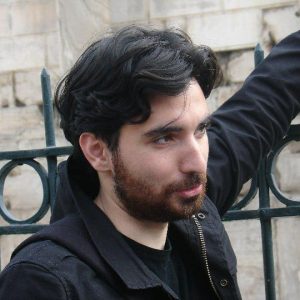
Ο Στέλιος Λεκάκης σπούδασε κλασική αρχαιολογία και διαχείριση πολιτιστικής κληρονομιάς στο Πανεπιστήμιο Αθηνών και στο University College London. Είναι Ερευνητής στο Πανεπιστήμιο του Newcastle (αρχαιολογία, χαρακτηρισμός, πρόσληψη & διαχείριση του πολιτιστικού τοπίου) και διδάσκει Πολιτιστική Πολιτική στο Ανοιχτό Πανεπιστήμιο Κύπρου και Πολιτική Οικονομία στο Ελληνικό Ανοιχτό Πανεπιστήμιο. Συνεργάζεται με ΜΚΟ (ιδρυτικό μέλος της MONUMENTA) και Πανεπιστήμια ως Σύμβουλος Διαχείρισης Πολιτιστικής Κληρονομιάς στην Ελλάδα και το εξωτερικό, ιδιαίτερα σε προγράμματα συμμετοχικών στρατηγικών διαχείρισης και πολιτιστικής πληροφορικής. Μελέτες του έχουν δημοσιευθεί σε ακαδημαϊκά περιοδικά και συλλογικούς τόμους.
Επιλεγμένες Δημοσιεύσεις
- Lekakis, S. (ed). Cultural heritage in the realm of the commons. London: Ubiquity Press (forthcoming)
- Lekakis, S. Archaeology on the front line: digging politics in Asia Minor 1919–1922. Heritage Turkey 8 (forthcoming)
- Lekakis, S., Shakya, S., Kostakis, V., 2018. Bringing the community back: Α case study of the post-earthquake heritage restoration in Kathmandu valley. Sustainability 2018, 10, 2978.
- Lekakis, S., 2018. “To the splendour of our Byzantine heritage”. Managing Orthodox churches in the island of Naxos, in J.Crow, D.Hill (eds.), Naxos and the Byzantine Aegean: Insular Responses to Regional Change Papers and Monographs from the Norwegian Institute at Athens, Vol. 7. Athens: Norwegian Institute at Athens: 371-390
- Λεκάκης, Σ., 2017. Νησιωτικοί κόσμοι: Συζητώντας τις έννοιες του νησιού και της νησιωτικότητας στο Αιγαίο, στο Μ. Σέργης, Β. Φραγκουλόπουλος (επιμ.) 2017, Πρακτικά του Ε΄ Πανελληνίου Συνεδρίου: Η Νάξος διαμέσου των Αιώνων. Νάξος: Δήμος Νάξου & Μικρών Κυκλάδων, 785-800
- Λεκάκης, Σ., Γρατσία, Ε., Σιδέρη, Α. (επιμ.), 2016. Πράττουμε για τα μνημεία. Αθήνα: Εκδόσεις MONUMENTA. Συνεπιμέλεια πρακτικών της 3ης ημερίδας-δημόσιας συζήτησης του προγράμματος «Τοπικές Κοινωνίες & Μνημεία» με εκτεταμένη εισαγωγή, πρόλογο και αγγλική περίληψη.
- Λεκάκης, Σ., 2016. H διαχείριση της πολιτιστικής κληρονομιάς στην Ευρώπη και την Ελλάδα. Μια επισκόπηση, στο Μ. Φιλήμονος, Β. Νικολόπουλος και Χρ. Μητσοπούλου (επιμ.), Η αρχαιολογία στην Ελλάδα του σήμερα. Πρακτικά του συνεδρίου της ΗΩΣ, 24-25.05.15. Αθήνα: ΗΩΣ, 115-132
- Lekakis, S., 2012. The Cultural Property debate, in T. Smith, D. Plantzos, 2012. A Companion to Greek Art, vol.2. Oxford: Wiley-Blackwell, 683-697





